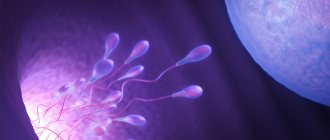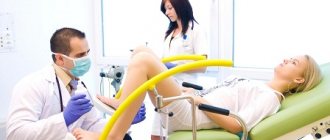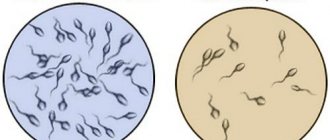The most favorable period is considered to be 3-4 days before ovulation and the day the female cell is released. But is it possible to get pregnant after ovulation... When wanting to conceive a child, it is important to know the characteristics of the female body and reproductive system. For pregnancy to take place, sexual intercourse must occur on the right days of the cycle - the ovulation phase. The article describes all possible options for conception after ovulation, the lifespan of the egg and what stages it goes through after fertilization.
Pregnancy is possible
The ovulatory phase is the shortest in the cycle. This stage is the main one, since fertilization can occur within 5 days of the phase. On the way to the desired pregnancy, girls try to find out as much information as possible about the days suitable for conception.
Sexual intercourse a few days before, during and immediately after ovulation can lead to pregnancy.
The lifespan of sperm is longer than that of an egg, so fertilization is possible through sexual contact 3-4 days before the female cell leaves the follicle.
During ovulation, you are most likely to conceive. You can determine the required day with high accuracy using ultrasound or laboratory tests. The accuracy of special tests and basal temperature charts is high, but these methods can lead to errors in calculations.
If a girl feels discomfort, tingling in the area of one of the ovaries, breast swelling, changeability in mood, then ovulation has already occurred. Pregnancy after ovulation is possible, but it should be remembered that the lifespan of the egg is very short.
A little physiology
As you know, pregnancy occurs only when male and female cells merge. And if sperm can be “received” every day (although the process of their full maturation in the testicles lasts 64-74 days), then the egg is available only at a certain time - during the period of ovulation.
During this time, called the ovulatory phase of the menstrual cycle, the oocyte must:
- exit from the follicle that fed it into the abdominal cavity;
- to be caught in the villi of the fallopian tubes;
- through them enter the uterine cavity.
The egg lives for 6-7 days, during which it moves from the ovary to the cervix, but the viability of the cell, regulated by female hormones, remains for 24-36 (in rare cases 48) hours.
It turns out that during the first two days (in other words, immediately after ovulation) the risk of getting pregnant is maximum. Given this information, when should sexual intercourse take place?
The speed of sperm movement is 2-4 mm/minute. Full ejaculation increases their speed, so they can reach the uterus in 1-2 minutes, and then they will slow down. But fertilization should occur not in the uterus itself, but at the place where the fallopian tube passes into it. To get there, normal, full-fledged sperm need several hours.
How many days after ovulation can you get pregnant?
Conception occurs after the female cell exits the tube. While the egg is viable, it is ready to merge with a sperm. The female gamete dies 1-2 days after maturation. Only during this short phase can fertilization occur.
What is the probability of getting pregnant after ovulation? The chance of conception after ovulation decreases from high to average. The likelihood of getting pregnant is influenced by various factors, due to which the viability of germ cells can increase or decrease.
- No bad habits. Smoking, alcohol, and drugs interfere with the proper functioning of the reproductive organs. Reproductive cells often become unviable under the influence of addictions.
- Healthy lifestyle. Walking and following a daily routine prolong the life of germ cells.
- Compliance with the principles of proper nutrition affects not only the functioning of the reproductive system, but also the entire body. Certain foods make vaginal secretions favorable for sperm life. Consumption of some foods, on the contrary, contributes to their death. Diets during the ovulation phase are prohibited, since the body is under stressful conditions and directs all its forces to survival, and not to conception.
- Moderate physical activity improves blood flow to the pelvic organs. Saturation with oxygen and nutrients positively changes the quality of sperm and the viability of the egg. Excessive physical activity, on the contrary, suppresses the functioning of the reproductive system.
The average lifespan of a female cell is 1-2 days. With individual characteristics and a healthy lifestyle, its functioning period can increase to 4 days.
The possibility of fertilization is influenced by the quality of the sperm of the sexual partner. Nimble sperm are more likely to reach their target in the short period of time remaining after ovulation.
The position for conception also plays an important role. In order for fertilization to occur after ovulation, it is necessary to minimize the path of sperm to the female cell. Poses where the man is on top or behind are suitable for this.
According to the longest standards, sexual intercourse can lead to conception on a maximum of the 3rd day after ovulation.
Factors negatively affecting conception
- Changes in hormonal levels. Due to hormonal shifts, ovulation may not occur at all, or may be delayed. This factor can be successfully corrected by a gynecologist by prescribing therapy.
- Changes in spermogram. Caused by a decrease in sperm motility, or a deterioration in their quality. Men need to give up bad habits, start leading an active lifestyle, enrich their diet with foods rich in vitamins A and E, and folic acid. Couples should avoid daily sex when planning pregnancy. It is optimal to have sex every other day
- Chronic inflammatory diseases of the pelvic organs. A common cause of disruption of the movement of the egg from the follicle into the uterine cavity. As a result of inflammation, adhesions are formed; they are a mechanical obstacle to the path of germ cells. Occurs after an abortion, acute appendicitis in childhood, adnexitis, chronic infections of the genitourinary tract
- Immunological incompatibility of partners. Rarely encountered, it is diagnosed by performing a postcoital test. Treated with medications
- Psychological aspects. In women, with excessive emphasis on the problem of pregnancy, fertility is often impaired. In these cases, the help of psychotherapists is effective.
Is it possible to get pregnant the next day
According to average indicators, conception can occur immediately after the release of the egg or the next day. While the female cell is viable, the sperm that quickly reaches the target will have time to fertilize it.
The chance of getting pregnant after ovulation the next day is much lower than immediately after the egg is released, but is still quite high. Still, you can get pregnant after ovulation. However, your chance of getting pregnant the day after ovulation is only 10.3%, which is about half as much as 2 days before ovulation. Or, directly during ovulation itself.
The main causes of premature ovulation
Ovulation ahead of time can occur for a number of reasons, which include:
- taking certain medications;
- sudden weight loss or gain;
- exposure to stress factors, including climate change, environment and lifestyle;
- excessive physical activity;
- various diseases.
All these factors can cause sudden fluctuations in hormone levels that are not noticeable to a woman, but significant for the body, which affect the duration of the menstrual cycle and “postpone” ovulation to an earlier date.
Is it possible to get pregnant in a week
It is impossible to get pregnant after ovulation a week later. Even strict adherence to all the rules that extend the life of reproductive cells will not help you conceive a week after the release of the egg. The lifespan of a female cell can be maximally extended to 4 days.
Fertilization can occur a week after expected ovulation. Each girl's cycle follows an individual pattern, so calculating ovulation according to generally accepted standards often leads to errors.
For example, according to the calendar method, the egg was released on the 14th day of the cycle. In fact, ovulation occurred on day 20, so intercourse on day 21 (a week after the egg was supposed to be released) resulted in pregnancy.
Having accurately determined the date of ovulation, it is impossible to get pregnant a week after it.
How often should you have sex when trying to conceive?
Couples in normal health do not need to calculate the onset of the ovulatory phase. With constant sexual intercourse for 3 months, conception occurs. It is considered normal if the chance of getting pregnant occurs within a year with unprotected regular sex. If conception does not occur by this time, the man and woman should check their reproductive health.
The optimal frequency of sexual intercourse is once every two days. During this period, the amount of seminal fluid and sperm, even in men with changes in the spermogram, returns to normal. Sex for the purpose of conception can be practiced both during ovulation and two days before it. Sperm that enter the uterus remain viable for about two days, and are able to catch the moment the egg leaves the follicle.
Signs of fertilization
It is impossible to feel fertilization immediately after ovulation. The egg and sperm are so small that they are invisible to the naked eye. The fusion of these two cells occurs asymptomatically.
The first signs of pregnancy after ovulation can be felt 5-7 days later, when the fertilized egg reaches the uterus and implants into it. Often this process does not cause any sensation, but 50% of women feel a short-term tingling in the uterus that accompanies attachment. Within 2 days after implantation, a drop of blood may appear on the underwear. This symptom is considered the first sign of pregnancy.
After the zygote implants into the uterus, the production of hCG, a hormone that supports pregnancy, begins. The amount of hCG increases rapidly every day, creating favorable conditions in the body for the development of pregnancy. This process is accompanied by the following symptoms:
- enlargement and heaviness in the chest;
- changing the color of the nipple halo from pink to brown;
- mild cramps in the lower abdomen;
- increase in basal temperature to 37 degrees and above.
Malaise, nausea and other classic pregnancy symptoms occur later, 3-4 weeks after ovulation.
It is very difficult to determine pregnancy by the first signs, since they often coincide with the sensations of premenstrual syndrome.
Ovulation and menstrual cycle
Every month, a number of physiological processes occur in a woman’s body that ensure the functioning of the reproductive system in such a way that the conception and development of a new organism will be possible. These changes are cyclical (once completed the cycle begins again) and are called the menstrual cycle. Its duration depends on the individual characteristics of the body and can normally range from 21 to 35 days. In gynecological practice, the concept of an “ideal” cycle is accepted, which lasts exactly 28 days. With such a duration, it is most convenient to calculate its phases and control their change. The beginning of the menstrual cycle is considered the first day of bleeding (menstruation), and the end is the day preceding the next menstruation, i.e., the beginning of a new cycle.
According to statistics, only 13% of all women have a cycle of exactly 28 days.
Great Medical Encyclopedia
Follicle maturation
From the very first day of the monthly cycle, active maturation of follicles begins: several eggs (about a dozen) are surrounded by follicular cells, as a result of which follicles are formed. But during one menstrual cycle, as a rule, only one of them reaches full maturity.
In rare cases, two or three follicles mature, which can lead to multiple pregnancies and the birth of fraternal twins.
The average diameter of a human egg is 88–91 microns. The follicle in which it is contained, during the process of maturation, increases by about 2 mm every day and by the time of ovulation it grows to 20 mm in diameter. Its internal space is filled with fluid and granulosa cells, which produce female sex hormones (estrogens). Normally, the follicle matures within two weeks. By the end of the second week, the level of hormones increases so much that it provokes the release of luteinizing hormone, under the influence of which the follicle ruptures. Formations that have not reached full maturity dissolve.
The follicle matures completely by the 14th day of the cycle
The ruptured follicle turns into a corpus luteum, which begins to actively produce another hormone - progesterone. It is under the influence of progesterone that the endometrium of the uterus is prepared for the implantation of an embryo into it. If fertilization does not occur, the corpus luteum dissolves on its own and the cycle begins again.
The egg during and after ovulation
After about half the cycle, ovulation occurs - this is the release of a fully mature egg, ready for fertilization, from the burst follicle.
Eggs are laid during the period of intrauterine development of the female body, and by the time of puberty their number is 300–400 thousand.
When the female body reaches puberty, the first ovulation occurs. The latter will happen during menopause (menopause) - the cessation of follicle maturation and the cessation of menstrual function. Ovulation also does not occur during pregnancy, but after the birth of the child it is restored.
The duration of the process of releasing an egg from the ovary varies from person to person. The ovulation phase is determined to last up to three days. After leaving the ovary, the egg lives from 12 to 48 hours.
Fertilization is the very first stage in the birth of a new life.
Having freed itself from the follicular membrane, the egg is captured by the fimbriae of the fallopian tube and begins to move along it towards the uterus. When an egg meets a sperm, fertilization occurs. If it does not occur, the egg is destroyed. Otherwise, it begins to divide, moving further to the uterus, where after 5-6 days it attaches (implants) to its wall. From this point on, the follicles stop maturing and the menstrual cycle stops. Pregnancy begins.
What are periods and when do they occur?
After the completion of the cycle, during which the sequential development of follicles, ovulation, destruction of the corpus luteum and unfertilized egg occurs, menstruation begins (menstruation), and, accordingly, a new menstrual cycle starts.
Menstruation is a bloody discharge from the female genital tract, the cause of which is the rejection of the inner layer of the uterine mucosa if a fertilized egg does not appear there within a certain period after ovulation (the second half of the cycle). After the resorption of the corpus luteum, the production of sex hormones decreases, which leads to a change in blood circulation in the endometrial vessels: first, expansion occurs, and then a sharp narrowing (spasm). The influx of new blood leads to its stagnation, which increases pressure on the walls of blood vessels. When it becomes excessive, the vessels rupture and bleeding begins. Constriction of the vessels of the uterine mucosa continues for about 48 hours from the beginning of menstruation, which causes pain in the lower abdomen in the first days of the cycle.
Menstruation is the monthly birth of an unfertilized egg.
V. F. Snegirev, Doctor of Medicine, Emeritus Professor of Moscow University, one of the founders of Russian gynecology
bme.org/index.php/MENSTRUAL_CYCLE
The normal duration of the discharge period varies from 2 to 8 days. During this time, on average, from 50 to 100 ml of blood comes out. A range from 10 to 150 ml is also considered normal. Sometimes the amount of blood released can reach 250 ml. If the volume exceeds these values or, conversely, does not reach the minimum, this may indicate a malfunction in the woman’s reproductive system or the presence of some disease.
How pregnancy occurs by day
Pregnancy does not occur immediately after ovulation. To find out about all the processes occurring in the embryo, you need to carefully study the table.
pregnancy by day
You can certainly find out about a pregnancy using a blood test, which will be informative no earlier than 10 days after the release of the egg.
It is recommended to take a pregnancy test at least 12 days after ovulation, since the level of hCG in the urine increases more slowly than in the blood.
Ultrasound at such a short time is not informative. During the study, the embryo and the fetal sac in which it is located will not yet be visualized. You can see successful conception by ultrasound no earlier than 3 weeks after the release of the egg.
Fertilization does not always mean pregnancy. The zygote may not be viable or strong enough to implant into the uterus.
If implantation has already occurred, but there are genetic abnormalities in the zygote, the body often “rejects” the unsuccessful pregnancy. This process can be signaled by menstruation after a positive test.
Tips for preparing for conception
- Quitting alcohol, smoking, and caffeine. Increase the share of fresh fruits and vegetables in your diet. It is necessary to visit a gynecologist to prescribe vitamins and minerals
- Have sex every other day. This will increase the concentration of sperm in the seminal fluid, making sperm more active
- Temporary refusal of intimate hygiene cosmetics. They are to some extent capable of changing the pH of the skin and mucous membranes and impairing sperm motility
- The correct position for conception. If the couple does not have health problems, the chances of becoming pregnant are high in any position. The main thing is that ejaculation occurs deep into the vagina. If the sperm count is insufficient, every milliliter is important. A suitable position is in which the woman lies on her back, or any other position in which the reverse flow of sperm after intercourse is excluded
- No stress factors. A woman's ability to conceive is greatly influenced by psychological factors. If a woman is constantly stressed at work, she should take a vacation. It is advisable to distract yourself from obsessive thoughts about the difficulty of conceiving, possible infertility
- Review of medications. If one of the couple has a chronic disease accompanied by constant use of medications, it is worth checking with the doctor about the effect of the drug on the ability to conceive and the future fetus











